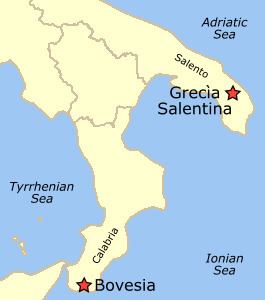Native to Italy Ethnicity Griko people | Region Salento | |
 | ||
Native speakers (20,000 cited 1981)
40,000 to 50,000 L2 speakers Language family Indo-European
Hellenic
Greek
Attic–Ionic
Italiot Greek
Griko Glottolog None
apul1236 (dialect of Salentino-Calabrian Greek) | ||
Griko, sometimes spelled Grico, or Grecanic, is the dialect of Italiot Greek spoken by the Griko people in Salento. Some Greek linguists consider it to be a Modern Greek dialect and often call it Katoitaliotikà (Greek: Κατωιταλιώτικα, "Southern Italian") or Grekanika (Γρεκάνικα), whereas its own speakers call it Katoitaliótika (Κατωιταλιώτικα) or Griko (Γκρίκο). Griko and Standard Modern Greek are partially mutually intelligible.
Contents
Classification
The most popular hypothesis on the origin of Griko is the one by Gerhard Rohlfs and Georgios Hatzidakis, that Griko's roots go as far back in history as the time of the ancient Greek colonies in Southern Italy and Sicily in the eighth century BC. The Southern Italian dialect is thus considered to be the last living trace of the Greek elements that once formed Magna Graecia.
There are, however, competing hypotheses according to which Griko may have preserved some Doric elements, but its structure is otherwise mostly based on Koine Greek, like almost all other Modern Greek dialects. Thus, Griko should rather be described as a Doric-influenced descendant of Medieval Greek. The idea of Southern Italy's Greek dialects being historically derived from Medieval Greek was proposed for the first time in the 19th century by Giuseppe Morosi.
Geographic distribution
Two small Italiot-speaking communities survive today in the Italian regions of Calabria (Province of Reggio Calabria) and Apulia (peninsula of Salento). The Italiot-speaking area of Salento comprises nine small towns in the Grecìa Salentina region (Calimera, Martano, Castrignano de' Greci, Corigliano d'Otranto, Melpignano, Soleto, Sternatia, Zollino, Martignano), with a total of 40,000 inhabitants. The Calabrian Greek region also consists of nine villages in Bovesia, (including Bova Superiore, Roghudi, Gallicianò, Chorìo di Roghudi and Bova Marina) and four districts in the city of Reggio Calabria, but its population is significantly smaller, with around only 2000 inhabitants.
Official status
By Law 482 of 1999, the Italian parliament recognised the Griko communities of Reggio Calabria and Salento as a Greek ethnic and linguistic minority. It states that the Republic protects the language and culture of its Albanian, Catalan, Germanic, Greek, Slovene and Croat populations and of those who speak French, Franco-Provençal, Friulian, Ladin, Occitan and Sardinian.
Culture
There is rich oral tradition and Griko folklore. Griko songs, music and poetry are particularly popular in Italy and Greece. Famous music groups from Salento include Ghetonia and Aramirè. Also, influential Greek artists such as Dionysis Savvopoulos and Maria Farantouri have performed in Griko. The Greek musical ensemble Encardia focuses on Griko songs as well as on the musical tradition of Southern Italy at large.
Samples
Sample text from Καληνύφτα – Kalinifta ("Good night") and Andramu pai, popular Griko songs:
